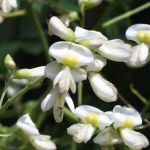| Common Name: |
Japanese Pagoda Tree |
| Botanical Name: |
Sophora japonica |
| Genus: |
Sophora |
| Family: |
Papilionaceae |
| Native Location: |
China, Korea |
| Cultivation: |
Well-drained soil in sun. |
| Propagation: |
By seed sown when ripe (species only); by grafting in late winter (cultivars of S. japonica). . |
| Harvest: |
Roots (S. flavescens) are lifted in autumn. Flowers and flower buds (S. japonica) are picked in late summer. Fruits are collected in autumn. All parts are dried for use in decoctions. |
| Height: |
25m (80ft) |
| Width: |
20m (70ft) |
| Variations: |
Pendula
Has weeping branches and rarely flowers.
Height: 3m (10ft)
Weight: 3m (10ft) |
Violacea
Has lilac-tinged flower |
|
| Hardiness: |
Z5-8 |
| Parts Used: |
Flowers (including buds, huai hua), fruits (huai jiao) |
| Properties: |
A bitter, cooling, anti-bacterial herb that controls bleeding. It also lowers blood pressure and cholesterol levels, strengthens capillaries, reduces inflammation, and relaxes spasms (flowers); soothes irritated and damaged tissues, increases blood sugar levels, expels intestinal parasites, and improves liver functions (fruits). |
| Medicinal Uses: |
Internally for internal hemorrhage; hypertension and poor peripheral circulation; intestinal worms, liver energy imbalance with symptoms such as tight chest, dizziness, headache, red eyes, and hypertension. |
| Warning: |
Contraindicated during pregnancy. |
| Bibliography: |
Encyclopedia of Herbs by Deni Brown Copyright © 1995, 2001 Dorling Kindersley Limited. pg 372 |
